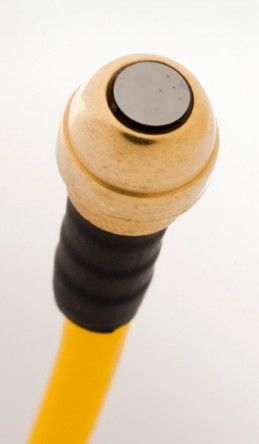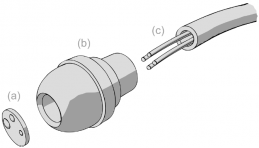‘Orca ears’ inspire researchers to develop ultrasensitive undersea microphone
June 27, 2011

A miniature underwater microphone (credit: L.A. Cicero)
Imagine a miniature microphone that responds to ocean sounds from 1 to 100kHz (a deep inaudible rumble to ultrasonic sounds) with a dynamic range of 160 dB (a whisper in a quiet library to the sound from 1 ton of TNT exploding 60 feet away) and operates at any depth.
An amazing microphone that does all that — modeled after the extraordinarily acute hearing of orcas — has been developed by Onur Kilic and other researchers at Stanford University.
At the core of the microphone, the researchers fabricated a silicon chip with a thin membrane (diaphragm) about 500 nanometers thick and drilled a grid of tiny holes (about 100 nanometers) in it, to allow water flow into the microphone, keeping the water pressure on each side of the membrane equal, no matter how deep.
They ran a fiberoptic cable into the water-filled microphone, with the end of the cable positioned near the inside surface of the diaphragm. They then shot light from a laser out the end of the cable onto the diaphragm. When the diaphragm was deformed ever so slightly by a sound wave, the intensity of the light reflected back into the cable was altered, which was measured with an optical detector.

Exploded view of the sensor structure showing (a) the silicon-based sensor chip, (b) the brass backchamber, and (c) the fiber bundle, each fiber with a mirror at its tip (credit: Onur Kilic et al./Acoustical Society of America)
The result was a hydrophone that would function at any depth and could detect and measure sound with extreme accuracy. But to be able to capture the full range of volumes they were after (a spread of 160 decibels), they needed not just one diaphragm, but three.
By giving each diaphragm a different diameter, they were able to “tune” each one to maximize its sensitivity to a different part of the range of volumes they wanted to detect.
One was tuned to measure quiet sounds on the library-whisper end of the spectrum, one was attuned more to the loud, TNT explosion end of the range, and the third was tuned to the mid-range volumes.
Since they all measured the exact same signal — just with different degrees of responsiveness — they worked like a single sensor.
Kilic said the uses for this would include ocean surveys and using the ocean as a giant neutrino detection system. He also told me the microphone fibers could be made into an array, which would allow for even greater sensitivity as well as localization. One could create a system that would operate very much like whale’s hearing (ranging over thousands of miles) and even do 3-D imaging.
He couldn’t comment on it, but this technology was funded by Litton Systems Inc., a subsidiary of Northrop-Grumman, and seems perfect for long-distance submarine detection and for communicating signals via sound in the ocean, perhaps covertly over long distances.